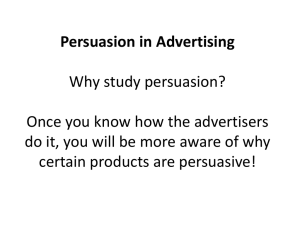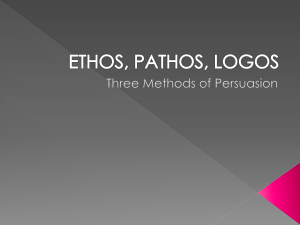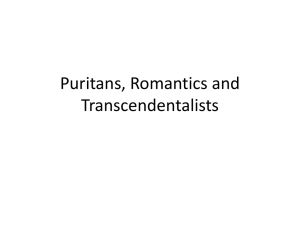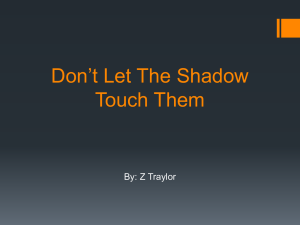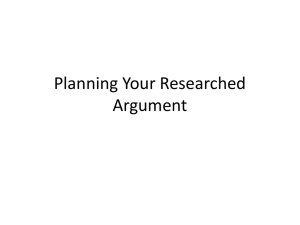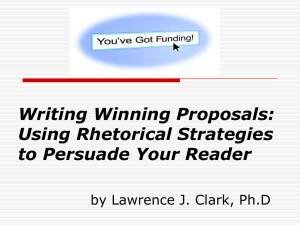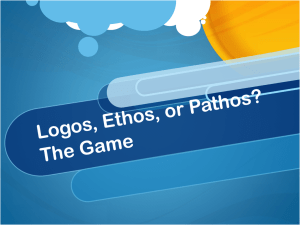The Art of Rhetoric: Ethos, Pathos and Logos
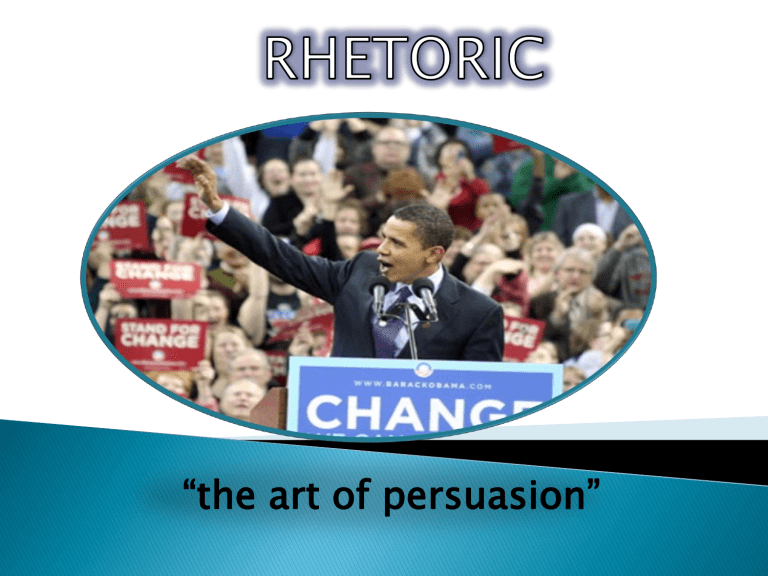
“the art of persuasion”
1. The art of speaking or writing effectively
2 . Writing, speaking or communicating as a means of persuasion.
Speeches
Advertisements
Films
Media
Conversation
The classroom
Rhetoric originated in Ancient Greece , where political leaders would use their public speaking abilities to persuade people for political decisions.
Rhetoric was also used to spread new ideas and philosophies during this time.
The ancient Greeks referred to it as “the art of persuasion,” and created a discipline so it can be studied.
Divided rhetoric into three essential components:
Logos
,
Pathos
and
Ethos
.
How the character and credibility of a speaker will influence an audience.
Example:
Listening to a speech by a top NASA scientist on climate change, rather than a first year university student.
Speaker must also be impartial
( not biased ) or else they lose credibility. i.e. Having an oil company appoint a scientist to lecture against on climate change would constitute a bias.
BIAS : having a slanted or distorted point of view; having a subjective point of view as opposed to an objective one
SUBJECTIVE: based on one’s opinions and feelings
OBJECTIVE: based on fact, NOT influenced by personal feelings
WOULD YOU BUY A USED CAR FROM THIS MAN?
Which Second World War politician is more credible?
Which politician would you trust more?
What subjects would
Stephen Hawking be a credible speaker?
What subject might he not be so credible?
Based on reputation – which pretty, little liar is most trustworthy?
Is Lebron
James a credible spokesperson for Nike basketball products?
WHY?
Is he a credible spokesperson for all products?
Which products would you NOT buy even if Lebron recommended them?
Have you seen Katy
Perry’s “ProActiv ads?
Is she a credible spokesperson?
Why is Tiger recommending “YOU” buy this brand of watch?
Is it because he knows a lot about watch construction?
OR is it because . . . . . . . . . . . . He is paid.
Why did many companies ditch Tiger Woods as a spokesperson for their products?
The use of emotional appeals to alter the audience’s judgement.
This can be done through a variety of means; however, the intention is to evoke strong emotional responses from the audience.
Examples: Story telling, quotes, personal references, rhetorical devices (metaphor, similes).
Terry Fox was diagnosed with bone cancer at the age of 18 and lost his right leg below the knee. He made up his mind to run to raise money for cancer research, and calling his challenge the Marathon of
Hope, he managed to run 26 miles a day for 143 days, from St. John's Newfoundland to Thunder Bay,
Ontario with an artificial leg. His spirit captured the country. He began on April 12, 1980 in St.
John's Newfoundland, and after 5,373 kilometres
(3,339 miles) his cancer reappeared, and he was forced to stop near Thunder Bay. He passed away on June 28, 1981 just a month before his 23rd birthday, but his spirit has carried on.
Using reasoning or logic to construct an argument.
Examples: Using math or statistics to persuade the audience.
“Our product is 50% more effective than our competitors.”
“Contains 33% less fat.”
Can also involve the use of hypothetical situations or anecdotes.
A friend of yours says he will never wear a seatbelt again. He explains that an acquaintance of his survived a car accident because she wasn't wearing a seat belt. The acquaintance flew through the windscreen, landed on a grassy bank and suffered minor injuries. Meanwhile the car burst into flames and was destroyed.
Often, advertisements use testimonials to sell products. A testimonial is a personal anecdote in which a person recounts his or her success with a product.
Her story is intended to make you believe that your experience will be similar.
IDENTIFY THE FOLLOWING AS EXAMPLES OF
- ETHOS
- PATHOS
- LOGOS
PATHOS
LOGOS
ETHOS
Advertisements that use sex appeal and misassociation also employ to a lesser extent, pathos.
PATHOS
LOGOS
LOGOS
&
PATHOS
LOGOS
LOGOS
PATHOS and ETHOS:
Look at the picture that has been chosen.
Let's say a friend of yours claims that a particular brand of inexpensive shower cleaner is really good. Your friend explains that he simply sprayed it on the tiles, left it for 10 minutes, and when he came back the tiles were spotless - without him having scrubbed or done anything else! This anecdotal evidence is enough of a recommendation for you. You buy some and use it, thus testing the evidence for yourself.
ETHOS:
Is this a friend you trust and would believe?
LOGOS:
The speaker is relaying a personal experience.
ETHOS
PATHOS
ETHOS
&
PATHOS
ETHOS
PATHOS
ETHOS
LOGOS
PATHOS
ETHOS
LOGOS
PATHOS
ETHOS: Do you believe Amnesty
International?
LOGOS
&
PATHOS
LOGOS
ETHOS
LOGOS
&
ETHOS
PATHOS
&
LOGOS
Ethos – “plain folks,” everyday people are often viewed as more reliable than celebrities.
The story begins in
Indianapolis, Indiana, where Jared S. Fogle who was attending North
Central High School, was massively overweight, weighing in at 425 pounds
As a student of Indiana
University, Jared roomed with a medic who diagnosed him with oedema.
He began a diet of a 6-inch turkey club sandwich for lunch, and a footlong veggie sub for dinner. The diet was a success; within three months, Jared had shed almost 100 pounds, and the visible reduction in his size spurred him to begin taking regular exercise. Rather than using transport, Jared began to walk everywhere he could and choosing to take the stairs wherever possible. By the end of the diet, he had lost over 240 pounds.
ETHOS
LOGOS – anecdotal evidence
ETHOS: Does
Dion appear believable.
PATHOS: This ad preys on the voter’s
FEAR of being over taxed.
To a lesser extent, LOGOS: The ad implies that one tax (the carbon tax) is the beginning of a pattern.
Propaganda : Form of rhetoric where the truth is distorted (exaggerated, or understated),to sway the opinion of a certain audience.
Generally people in a position of authority will tend to use propaganda
.
The GERMAN NAZIS during World War II are considered masters of propaganda.
Gossip and rumours are often based on a “subjective” and one sided understanding of a situation.
The targets of such bullying are often only understood on a superficial level.
Sometimes the rumours and gossip people spread about others serve no other purpose than to bully and to hurt.
In many ways, gossip and verbal bullying are not that different from propaganda.
Nine teenagers charged over bullying that led to girl's suicide
Irish girl killed herself after enduring months of torment by classmates in person and online.
AP – Two teenage girls have been charged under Florida’s law against cyberbullying after authorities say they created a Facebook account in a classmate’s name and posted a faked nude photograph of her.
16-year-old Gary
Hansen, hanged himself in Roblin,
Man., after persistent bullying at the local Goose
Lake High
School.
A 13-year-old girl hanged herself after she fell victim to a cyber-bullying campaign orchestrated by the mother of one of her classmates, who masqueraded online as a "good looking" teenage boy.
“‘Sexting’ bullying cited in teen’s suicide”
13-year-old Hope Witsell hanged herself after topless photos circulated
Each person is different ; consequently, each individual brings different values, interests and goals into a relationship
It is , therefore, inevitable that in any relationship, conflict will arise.
MANY DIFFERENT
STRATEGIES ARE
AVAILABLE FOR
SOLVING
CONFLICT
1. AVOIDANCE: Run away, hide, sulk, do nothing
2. DENIAL: Pretend there is nothing wrong, do nothing .
3. AQUIESE: Give in.
4. DISCUSS: Talk and try to reach a solution satisfactory to both parties.
The first three will retain a certain level of chaos.
They often create and maintain stress and typically leave one person unhappy.
These conflicts typically resurface.
DISCUSSION:
If done well, a civilized discussion inevitably leads to a better understanding on the part of the individuals in conflict and a compromise solution often gives both parties a reason to be pleased.
The role your reputation plays in convincing your parents.
- How responsible have you been in the past?
- How mature are you in your actions and choices?
- Are you a responsible student?
- Are you a good role model for siblings?
- How have you handled freedom and responsibility the past?
The emotion you bring when pleading your case.
“ Why can’t I,” she begged, tears running down her cheek.
“Please, please.”
“You’d let me if you really loved me.’
Do you have strong logical reasons that would lead to a decision in your favour?
Anecdotal evidence indicating personal responsibility.
Facts or statistics.
Strategies that prove you can problem solve.
And, “everyone else is doing it” is not a good, logical argument.
You will be assigned a role and a topic to argue. Then you will need to write, and deliver a short speech that employs rhetorical devices to convince your audience.
Speeches will be around 150 – 200 words and will last between 60 and 90 seconds.
Pathos: use humour, sarcasm, wit, fear, sadness, guilt, anger, frustration, etc.
Ethos: sources of information, reason for selection of topic, experience or expertise, speech deliver (voice, eye contact, body language).
Logos: hypothetical situation, metaphors, facts\stats.
